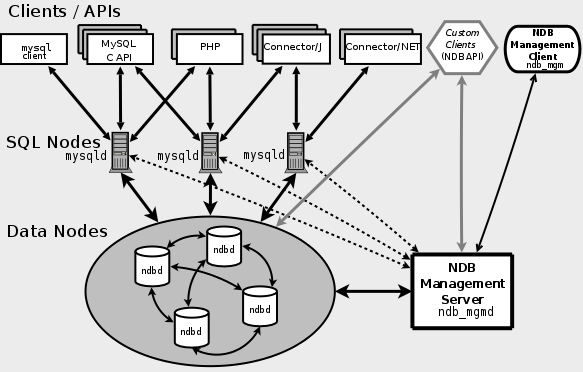[+/-]
MySQL Cluster is a technology that enables clustering of in-memory databases in a shared-nothing system. The shared-nothing architecture allows the system to work with very inexpensive hardware, and with a minimum of specific requirements for hardware or software.
MySQL Cluster is designed not to have any single point of failure. In a shared-nothing system, each component is expected to have its own memory and disk, and the use of shared storage mechanisms such as network shares, network file systems, and SANs is not recommended or supported.
MySQL Cluster integrates the standard MySQL server with an in-memory
clustered storage engine called NDB
(which stands for “Network
DataBase”). In our
documentation, the term NDB refers to
the part of the setup that is specific to the storage engine,
whereas “MySQL Cluster” refers to the combination of
one or more MySQL servers with the NDB
storage engine.
A MySQL Cluster consists of a set of computers, known as hosts, each running one or more processes. These processes, known as nodes, may include MySQL servers (for access to NDB data), data nodes (for storage of the data), one or more management servers, and possibly other specialized data access programs. The relationship of these components in a MySQL Cluster is shown here:

All these programs work together to form a MySQL Cluster (see
Section 17.4, “MySQL Cluster Programs”. When data is stored by the
NDB storage engine, the tables (and
table data) are stored in the data nodes. Such tables are directly
accessible from all other MySQL servers (SQL nodes) in the cluster.
Thus, in a payroll application storing data in a cluster, if one
application updates the salary of an employee, all other MySQL
servers that query this data can see this change immediately.
Although a MySQL Cluster SQL node uses the mysqld server damon, it differs in a number of critical respects from the mysqld binary supplied with the MySQL 5.1 distributions, and the two versions of mysqld are not interchangeable.
In addition, a MySQL server that is not connected to a MySQL Cluster
cannot use the NDB storage engine and
cannot access any MySQL Cluster data.
The data stored in the data nodes for MySQL Cluster can be mirrored; the cluster can handle failures of individual data nodes with no other impact than that a small number of transactions are aborted due to losing the transaction state. Because transactional applications are expected to handle transaction failure, this should not be a source of problems.
Individual nodes can be stopped and restarted, and can then rejoin the system (cluster). Rolling restarts (in which all nodes are restarted in turn) are used in making configuration changes and software upgrades (see Section 17.2.6.1, “Performing a Rolling Restart of a MySQL Cluster”). In MySQL Cluster NDB 7.0 and later, rolling restarts are also used as part of the process of adding new data nodes online (see Section 17.5.11, “Adding MySQL Cluster Data Nodes Online”). For more information about data nodes, how they are organized in a MySQL Cluster, and how they handle and store MySQL Cluster data, see Section 17.1.2, “MySQL Cluster Nodes, Node Groups, Replicas, and Partitions”.
Backing up and restoring MySQL Cluster databases can be done using the NDB native functionality found in the MySQL Cluster management client and the ndb_restore program included in the MySQL Cluster distribution. For more information, see Section 17.5.3, “Online Backup of MySQL Cluster”, and Section 17.4.17, “ndb_restore — Restore a MySQL Cluster Backup”. You can also use the standard MySQL functionality provided for this purpose in mysqldump and the MySQL server. See Section 4.5.4, “mysqldump — A Database Backup Program”, for more information.
MySQL Cluster nodes can use a number of different transport mechanisms for inter-node communications, including TCP/IP using standard 100 Mbps or faster Ethernet hardware. It is also possible to use the high-speed Scalable Coherent Interface (SCI) protocol with MySQL Cluster, although this is not required to use MySQL Cluster. SCI requires special hardware and software; see Section 17.3.5, “Using High-Speed Interconnects with MySQL Cluster”, for more about SCI and using it with MySQL Cluster.

User Comments
Add your own comment.